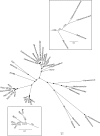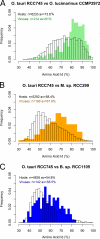Marine prasinovirus genomes show low evolutionary divergence and acquisition of protein metabolism genes by horizontal gene transfer
- PMID: 20861243
- PMCID: PMC3004350
- DOI: 10.1128/JVI.01123-10
Marine prasinovirus genomes show low evolutionary divergence and acquisition of protein metabolism genes by horizontal gene transfer
Abstract
Although marine picophytoplankton are at the base of the global food chain, accounting for half of the planetary primary production, they are outnumbered 10 to 1 and are largely controlled by hugely diverse populations of viruses. Eukaryotic microalgae form a ubiquitous and particularly dynamic fraction of such plankton, with environmental clone libraries from coastal regions sometimes being dominated by one or more of the three genera Bathycoccus, Micromonas, and Ostreococcus (class Prasinophyceae). The complete sequences of two double-stranded (dsDNA) Bathycoccus, one dsDNA Micromonas, and one new dsDNA Ostreococcus virus genomes are described. Genome comparison of these giant viruses revealed a high degree of conservation, both for orthologous genes and for synteny, except for one 36-kb inversion in the Ostreococcus lucimarinus virus and two very large predicted proteins in Bathycoccus prasinos viruses. These viruses encode a gene repertoire of certain amino acid biosynthesis pathways never previously observed in viruses that are likely to have been acquired from lateral gene transfer from their host or from bacteria. Pairwise comparisons of whole genomes using all coding sequences with homologous counterparts, either between viruses or between their corresponding hosts, revealed that the evolutionary divergences between viruses are lower than those between their hosts, suggesting either multiple recent host transfers or lower viral evolution rates.
Figures




References
-
- Abascal, F., R. Zardoya, and D. Posada. 2005. ProtTest: Selection of best-fit models of protein evolution. Bioinformatics 21:2104-2105. - PubMed
-
- Attoui, H., F. M. Jaafar, M. Belhouchet, P. de Micco, X. de Lamballerie, and C. P. Brussaard. 2006. Micromonas pusilla reovirus: a new member of the family Reoviridae assigned to a novel proposed genus (Mimoreovirus). J. Gen. Virol. 87:1375-1383. - PubMed
-
- Bellec, L., N. Grimsley, E. Derelle, H. Moreau, and Y. Desdevises. 2010. Abundance, spatial distribution and genetic diversity of Ostreococcus tauri viruses in two different environments. Environ. Microbiol. Rep. 2:313-321. - PubMed
-
- Bellec, L., N. Grimsley, H. Moreau, and Y. Desdevises. 2009. Phylogenetic analysis of new prasinoviruses (Phycodnaviridae) that infect the green unicellular algae Ostreococcus, Bathycoccus and Micromonas. Environ. Microbiol. Rep. 1:114-123. - PubMed
-
- Brown, C. M., D. A. Campbell, and J. E. Lawrence. 2007. Resource dynamics during infection of Micromonas pusilla by virus MpV-Sp1. Environ. Microbiol. 9:2720-2727. - PubMed
Publication types
MeSH terms
Substances
LinkOut - more resources
Full Text Sources
Molecular Biology Databases

